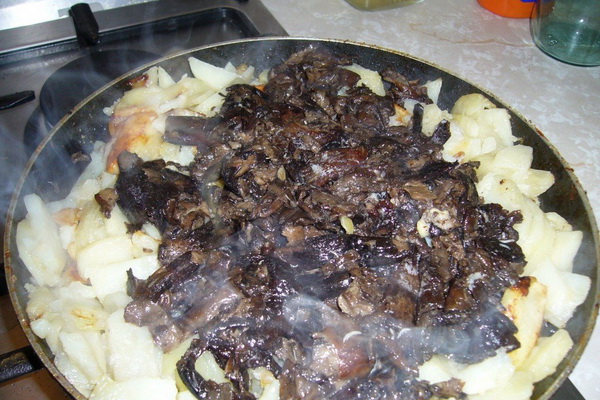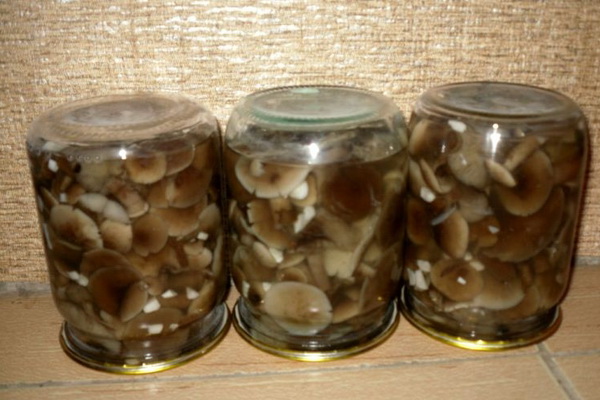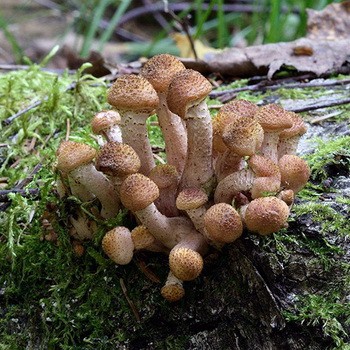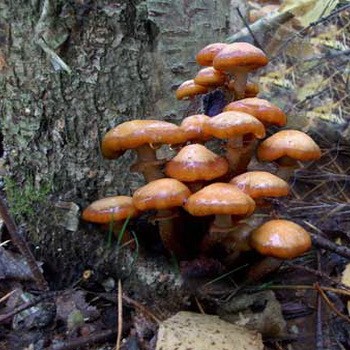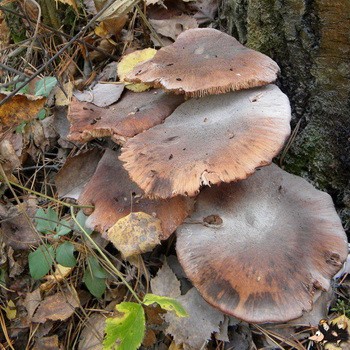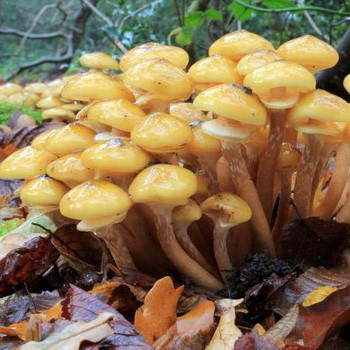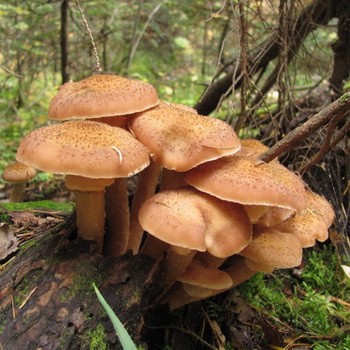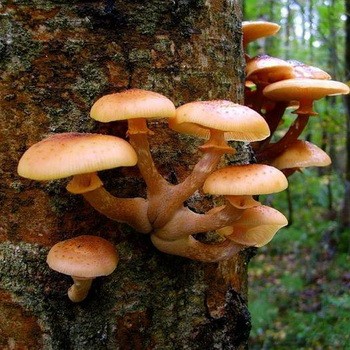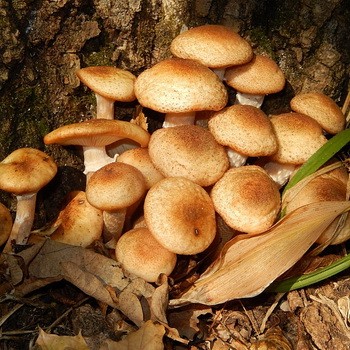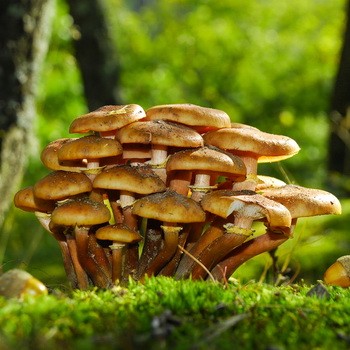Overgrown mushrooms: how they look and whether they can be collected
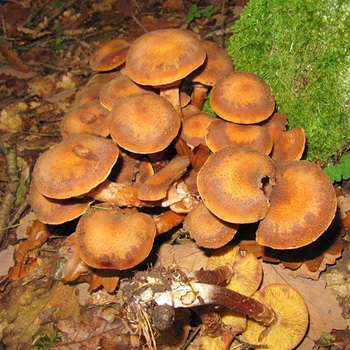
Content
- What mushrooms are considered overgrown and is it possible to eat old mushrooms?
- What do adult overgrown mushrooms look like: photos and descriptions
- Are adult overgrown mushrooms dangerous?
- Are overgrown mushrooms harmful and can they be taken?
- Is it possible to eat overgrown mushrooms and how to clean them?
- Is it possible to fry overgrown mushrooms and cook adult mushrooms in marinated form?
What mushrooms are considered overgrown and is it possible to eat old mushrooms?
Often, our searches are designed for strong, young mushrooms that are perfect for pickling and other processing processes. However, overgrown mushrooms can often be found in the forest. What to do in this case: pass or take them with you? Is it possible to eat old overgrown mushrooms, and if so, for what dishes are they suitable? In this article, we will show you a photo of mushrooms of honey agarics and tell you what you can do with them.
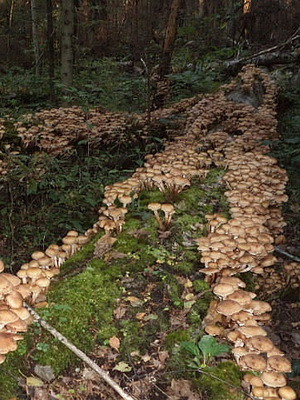
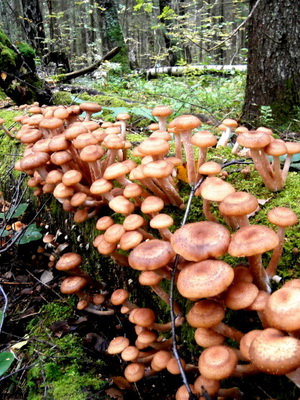
To know which mushrooms are considered overgrown, you need to familiarize yourself with the appearance of their younger "brothers." Identifying this mushroom in the forest is not difficult. In addition to the fact that they grow in whole colonies, there are many more characteristic descriptions. By its nature, honey agarics has a thin and flexible leg, the height of which can reach 15 cm. Edible species also have a skirt ring, which is one of the main differences from false counterparts. The cap of a young honey agaric is lamellar and has a hemispherical shape, the diameter of which is 2-6 cm. Small scales are visible from above, and the color of the cap varies from cream to reddish and even brown. The mushroom plates are rather rare, as if grown into a leg.
Honey mushrooms are considered very tasty mushrooms with a delicate grayish-white flesh and a pronounced aroma. You can meet these fruiting bodies in both coniferous and deciduous forests. Honey mushrooms prefer to grow mainly on stumps, from where their characteristic name came from. Therefore, pay attention to deforestation and ravines. In addition, you can find these mushrooms on the roots of trees, as well as just on the ground. Often you can find a colony of honey mushrooms on the trunks of drying trees.
Since mushroom honey agaric is a perishable product, it should be processed in the shortest possible time. These fruit bodies are most often used fresh for the preparation of first, second courses, appetizers, sauces, as well as fillings for flour products. They are fried, stewed, canned, salted, dried and frozen. Often the legs of mushrooms are not consumed, as they are quite stiff.
But despite the preference to look for young honey mushrooms, nevertheless, some mushroom pickers are not averse to gathering and overgrown edible mushrooms. If a lot of such mushrooms appeared in front of you in the forest, then you will ask a completely logical question: is it possible to collect overgrown mushrooms or is it better not to touch them?
What do adult overgrown mushrooms look like: photos and descriptions
Now, having discussed the general characteristics of the young honey agaric, you can also get acquainted with what adult mushrooms look like. It is worth noting that the representatives of these two age categories are somewhat different in appearance. The following photos and descriptions will help you see how overgrown mushrooms look.
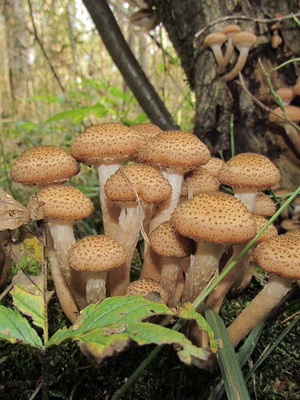
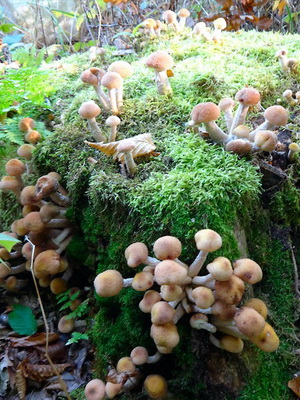
As already noted, young honey agarics have a hemispherical cap, as shown in the photo, and the hat is aligned in the overgrown mushrooms. With age, the upper part of the fruiting body takes the form of an umbrella - on top there is a slight bulge, then a plane that is slightly rounded on the sides. The hat of a mature individual has a diameter of 5 to 11 cm.
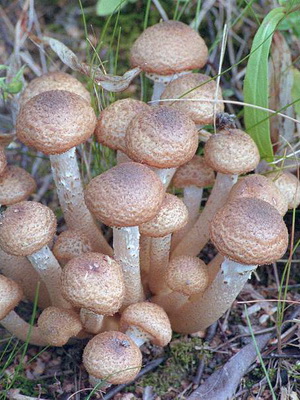
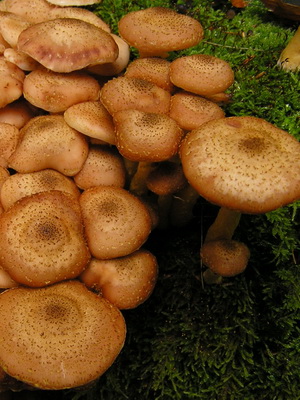
Edible young honey agaric covered with small scales, which can not be said about their adult "colleagues." With age, the mushroom cap loses these scales and becomes almost smooth. In addition, it loses the oily layer, which is sometimes inherent in some edible honey mushrooms.
As shown in the photo below, the flesh of adult edible mushrooms has a noticeable rough consistency compared to young individuals:
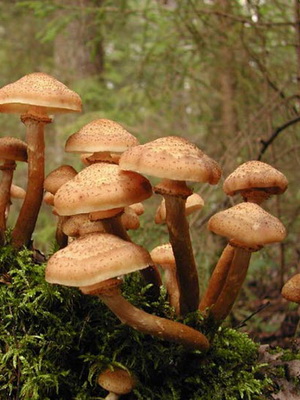
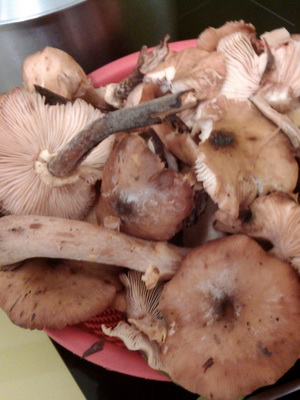
Also with age, the pulp of the fungus becomes less dense and more fibrous. In addition, you can also pay attention to the color of the plates. In young specimens, they have a white or flesh tint, but eventually acquire darker tones - pink or light brown. Sometimes the plates may be covered with brown spots. However, all these characteristics do not affect the pleasant smell and taste of the fruiting body. But still, it should be remembered that adult honey agarics do not have such a pronounced forest aroma, so they are less valued in cooking.
It is also known that with age the “skirt” of honey agarics becomes barely noticeable, and in some cases completely disappears. It is very important to remember this point, since the absence of a ring on the stem in young specimens indicates inedibility. Therefore, you should collect only those mature mushrooms in which you are sure that they belong to the category of edible fruiting bodies.
As you can see, as they ripen, honey agarics not only become larger in size, but also have a changed structure. There were times when one mature specimen could weigh up to 300 g.
We suggest you look at a few more photos showing how overgrown edible mushrooms look like:
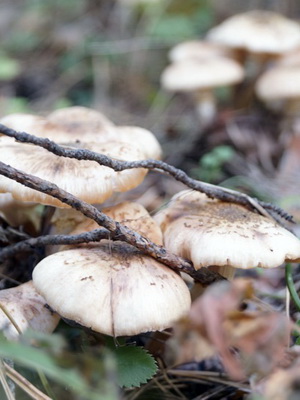
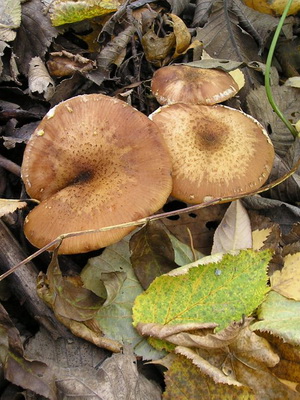
One of the most popular representatives of mushrooms on the territory of the northern part of Russia is considered to be autumn mushrooms. This is an edible species of fruiting bodies of the physialacry family, the genus of honey agarics. This fungus is parasitic, often grows in families, but there are also single individuals. “Settlement” of honey agarics on living trees and shrubs, dead stumps, fallen trunks and large broken branches. The fruiting body grows in deciduous and coniferous forests from late August to mid November, depending on the region.
It should be noted that young and adult autumn mushrooms differ from other species by quite noticeable signs. So, the size of the hat of a young specimen is up to 10 cm, and adult individuals are known for even larger dimensions. The cap of the ovum-overgrowth of the autumn can reach a diameter of 17 cm.
Young honey agarics have a distinct “skirt” on their legs, which becomes less noticeable with age. In addition, the surface of the entire fruiting body, including the peduncle, is dotted with thick scales. However, as shown in the photo, in the overgrown autumn mushrooms, these scales disappear, so the surface of the hat dries and becomes smooth:
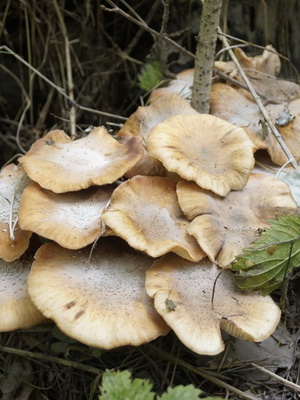
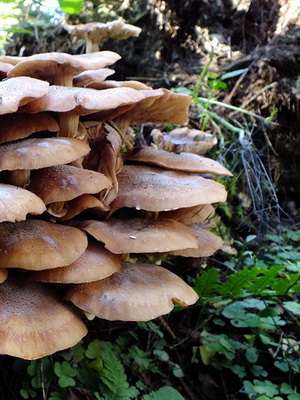
Another interesting feature showing how autumn mushrooms look like autumn is the presence of spores. The fact is that the spores of the fungus at a young age are white, so the hat often seems “moldy” in their “elderly” brothers.
Plates of autumn overgrown mushrooms change their color.If at a young age they are white-yellow in color, then over time they become creamy brown. However, it is worth saying that all of the above features do not affect the taste and aroma of the mushroom pulp, with the exception of rotten and wormy individuals. And although with age the aroma becomes less noticeable, nevertheless, some mushroom pickers do not mind collecting and cooking them.
Autumn honey mushrooms have an amazing property to glow at night. The mushroom picker, wrapping rotten stump around its thin threads, is able to highlight it from the inside. What do overgrown mushrooms look like, given this unique feature? Unfortunately, huge specimens almost completely lose it.
Are adult overgrown mushrooms dangerous?
This question is asked by almost all mushroom pickers who encounter mature mushrooms. After all, it is known that all types of fruiting bodies, without exception, absorb radiation and salts of heavy metals. And the older the mushroom, the more it has absorbed harmful substances from the air. Are overgrown mushrooms dangerous in this case?
I must say that it is rather rare to see an overgrown honey agaric, which will have high-quality indicators. The state in which the fruit body is located can be seen from its appearance. As a rule, over time, honey agarics change for the worse. The structure of his body is destroyed, and as a result, the fungus becomes flabby and loose. The hats dry out and then cracks appear on them. In this regard, the rigidity of the pulp of the fruiting bodies is significantly increased. In more detail, the features of adult honey mushrooms are shown in the photo, which is presented below:
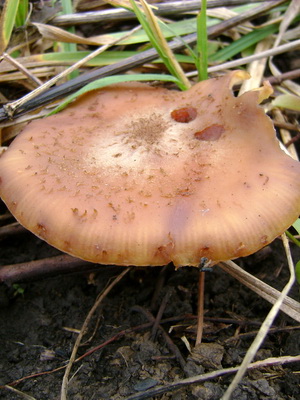
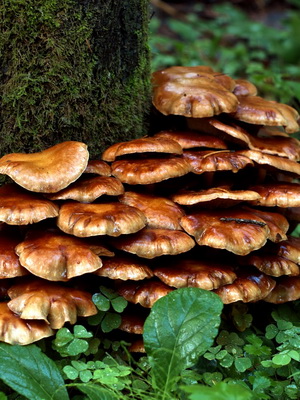
In addition, among mature fungi, you can often find moldy and wormy specimens. In some cases, an unpleasant odor even appears. If you notice any mold or blackness covering even the smallest part of the surface of the fungus, then you should refuse to collect them. In the same way, if the mushroom is damaged, loose, rotten, or it just causes you the slightest doubt, do not regret to pass by. Indeed, such external indicators clearly indicate the worminess of the fruiting body. And the unaesthetic look itself is unlikely to cause your appetite.
However, even among the overgrown mushrooms, you can find whole, strong, juicy and quite attractive "burdocks", which practically do not differ from their younger representatives. In this case, there is no reason not to take the mushrooms in your basket. Most likely, worms will be present in this fruiting body, however, this feature is easily fixable.
As already mentioned, mushrooms as “sponges” absorb harmful substances from the atmosphere, therefore it is strictly forbidden to collect them near roads, factories and other enterprises. Otherwise, you risk your health, because the concentration of heavy metal salts in such fruiting bodies can be critical. I must say that this rule applies not only to overgrown, but also to young mushrooms.
Are overgrown mushrooms harmful and can they be taken?
However, if you collected mushrooms in a reliable, proven place, you may ask: Are overgrown mushrooms harmful? Despite the fact that adult specimens partially lose their attractive appearance and taste, many mushroom pickers successfully give them a worthy place in their basket. The fact is that a significant part of the accumulated harmful substances can be disposed of through careful heat treatment. However, large fruiting bodies will require longer cooking than young and medium. As a rule, only a hat is collected from mature specimens, and the leg is thrown out due to excessive rigidity.
In addition, it is worth noting that eating honey agarics has contraindications. The fact is that these mushrooms are not recommended for children under 13 years old and people suffering from liver, kidney and gastrointestinal diseases.
As you can see, not all mature individuals are suitable for collection, so in this case, we recommend that you focus on their appearance.Recall that overgrown mushrooms can be taken only if you are confident in the place of gathering, as well as in their edibility.
Is it possible to eat overgrown mushrooms and how to clean them?
So, is it possible to eat overgrown mushrooms? If all collection rules were followed correctly, then why not. However, before proceeding directly to the cooking process, you need to learn how to clean overgrown mushrooms.
First you need to remove the legs, if you have not done this in the forest. Then the bottom layer of the plates should be removed so that one hat remains. I must say that in an aging mushroom, this spore-bearing layer becomes soft, so it can easily be separated with a knife.
As mentioned above, for such fruiting bodies it is necessary to conduct a more thorough and lengthy preparation. So, coming home from the forest, you must immediately soak the mushroom caps in water for 40-50 minutes. It is better to add a few tablespoons of table salt. This product will help to thoroughly clean the spores of the fruiting body from "settled" contaminants and worms that are probably present there. After which it is recommended to rinse the mushrooms at least three times, each time pouring a new portion of cold water.
Then overgrown honey mushrooms should undergo heat treatment. Given their age, the process should be longer. If for young mushrooms, an average of 20 minutes of cooking is sufficient, then for mature specimens, the time increases to 35 minutes. This time can be divided into 2 approaches (15-20 minutes each), each time changing the water.
Is it possible to fry overgrown mushrooms and cook adult mushrooms in marinated form?
Now, having completed the "ritual" of cleaning and boiling, you can start cooking. Is it possible to cook overgrown mushrooms in marinated form? Although aging specimens have a less attractive appearance, this procedure is still acceptable. Many mushroom pickers note that pickled overgrown mushrooms are very tasty and fragrant. Such a snack is given a worthy place even on the festive table. Combining fruit bodies in a marinade with various spices and ingredients, you can prepare an exquisite mushroom preparation for the winter.
Some housewives know another way where you can let aging mushrooms. The hats are dried and then ground into powder to be added to soups and sauces. However, in this case, soaking and boiling of the fruit bodies is not allowed. It is better to gently wipe each individual with a kitchen sponge and put it in a sunny, ventilated place.
Is it possible to fry overgrown mushrooms in a pan? Yes, and they will absolutely not differ in taste from their young "colleagues." Many who have tried fried mushrooms overgrown agree that their taste resembles portobello - the famous Italian mushroom that the local population loves to regale. Mature honey mushrooms can be fried with potatoes, vegetables or simply stewed in sour cream. Mushroom soup with these mushrooms will be very tasty on your table.
Photo of honey agarics in fried and pickled form:
